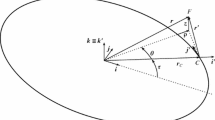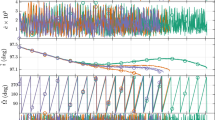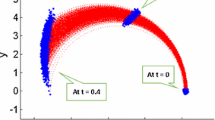Abstract
Most approximations for stochastic differential equations with high-dimensional, non-Gaussian inputs suffer from a rapid (e.g., exponential) increase of computational cost, an issue known as the curse of dimensionality. In astrodynamics, this results in reduced accuracy when propagating an orbit-state probability density function. This paper considers the application of separated representations for orbit uncertainty propagation, where future states are expanded into a sum of products of univariate functions of initial states and other uncertain parameters. An accurate generation of separated representation requires a number of state samples that is linear in the dimension of input uncertainties. The computation cost of a separated representation scales linearly with respect to the sample count, thereby improving tractability when compared to methods that suffer from the curse of dimensionality. In addition to detailed discussions on their construction and use in sensitivity analysis, this paper presents results for three test cases of an Earth orbiting satellite. The first two cases demonstrate that approximation via separated representations produces a tractable solution for propagating the Cartesian orbit-state uncertainty with up to 20 uncertain inputs. The third case, which instead uses Equinoctial elements, reexamines a scenario presented in the literature and employs the proposed method for sensitivity analysis to more thoroughly characterize the relative effects of uncertain inputs on the propagated state.


















Similar content being viewed by others
References
Ammar, A., Chinesta, F., Joyot, P.: The nanometric and micrometric scales of the structure and mechanics of materials revisited: an introduction to the challenges of fully deterministic numerical descriptions. Int. J. Multiscale Comput. Eng. 6(3), 191–213 (2008). doi:10.1615/IntJMultCompEng.v6.i3.20
Askey, R.A., Arthur, W.J.: Some basic Hypergeometric Orthogonal Polynomials that Generalize Jacobi Polynomials, vol. 319. AMS, Providence (1985)
Balducci, M., Jones, B.A., Doostan, A.: Orbit uncertainty propagation with separated representations. AAS/AIAA Astrodynamics Specialist Conference Hilton Head, SC, August 11–15 (2013)
Beylkin, G., Mohlenkamp, M.J.: Algorithms for numerical analysis in high dimensions. SIAM J. Sci. Comput. 26(6), 2133–2159 (2005). doi:10.1137/040604959
Beylkin, G., Garcke, J., Mohlenkamp, M.J.: Multivariate regression and machine learning with sums of separable functions. SIAM J. Sci. Comput. 31(3), 1840–1857 (2009). doi:10.1137/070710524
Blatman, G., Sudret, B.: Efficient computation of global sensitivity indices using sparse polynomial chaos expansions. Reliab. Eng. Syst. Saf. 95, 1216–1229 (2010). doi:10.1016/j.ress.2010.06.015
Chevreuil, M., Lebrun, R., Nouy, A., Rai, P.: A least-squares method for sparse low rank approximation of multivariate functions. arXiv preprint arXiv:1305.0030 (2013)
Chinesta, F., Ladeveze, P., Cueto, E.: A short review on model order reduction based on proper generalized decomposition. Arch. Comput. Methods Eng. 18(4), 395–404 (2011)
Cohen, A., DeVore, R., Schwab, C.: Convergence rates of best n-term Galerkin approximations for a class of elliptic spdes. Found. Comput. Math. 10(6), 615–646 (2010)
DeMars, K.J., Bishop, R.H., Jah, M.K.: Entropy-based approach for uncertainty propagation of nonlinear dynamical systems. J. Guid. Control Dyn. 36(4), 1047–1057 (2013). doi:10.2514/1.58987
DeMars, K.J., Cheng, Y., Jah, M.K.: Making best use of model evaluations to compute sensitivity indices. J. Guid. Control Dyn. 37(3), 979–984 (2014). doi:10.2514/1.62308
Doostan, A., Iaccarino, G., Etemadi, N.: A least-squares approximation of high-dimensional uncertain systems. Technical Report, Annual Research Brief, Center for Turbulence Research, Stanford University (2007)
Doostan, A., Iaccarino, G.: A least-squares approximation of partial differential equations with high-dimensional random inputs. J. Comput. Phys. 228(12), 4332–4345 (2009)
Doostan, A., Validi, A., Iaccarino, G.: Non-intrusive low-rank separated approximation of high-dimensional stochastic models. Comput. Methods Appl. Mech. Eng. 263, 42–55 (2013). doi:10.1016/j.cma.2013.04.003
Fann, G., Beylkin, G., Harrison, R., Jordan, K.: Singular operators in multiwavelet bases. IBM J. Res. Dev. 48(2), 161–171 (2004). doi:10.1147/rd.482.0161
Forrester, A., Sobester, A., Keane, A.: Engineering design via surrogate modelling: a practical guide. Wiley, Hoboken (2008)
Friedman, J., Hastie, T., Tibshirani, R.: The Elements of Statistical Learning, vol. 1. Springer, Berlin (2001)
Fujimoto, K., Scheeres, D.J., Alfriend, K.T.: Analytical nonlinear propagation of uncertainty in the two-body problem. J. Guid. Control Dyn. 35(2), 497–509 (2012). doi:10.2514/1.54385
Ghanem, R., Spanos, P.: Stochastic Finite Elements: A Spectral Approach. Springer, New York (1991)
Hadigol, M., Doostan, A., Matthies, H.G., Niekamp, R.: Partitioned treatment of uncertainty in coupled domain problems: a separated representation approach. Comput. Methods Appl. Mech. Eng. 274, 103–124 (2014). doi:10.1016/j.cma.2014.02.004
Hampton, J., Doostan, A.: Coherence motivated sampling and convergence analysis of least squares polynomial chaos regression. Comput. Methods Appl. Mech. Eng. 290, 73–97 (2015). doi:10.1016/j.cma.2015.02.006
Hansen, M., Schwab, C.: Analytic regularity and nonlinear approximation of a class of parametric semilinear elliptic PDEs. Math. Nachr. 286, 832–860 (2012)
Harrison, R.J., Fann, G.I., Yanai, T., Gan, Z., Beylkin, G.: Multiresolution quantum chemistry: basic theory and initial applications. J. Chem. Phys. 121(23), 11587–11598 (2004). doi:10.1063/1.1791051
Hoang, V.H., Schwab, C.: Sparse tensor Galerkin discretization of parametric and random parabolic PDEs—analytic regularity and generalized polynomial chaos approximation. SIAM J. Math. Anal. 45(5), 3050–3083 (2013)
Horwood, J.T., Aragon, N.D., Poore, A.B.: Gaussian sum filters for space surveillance: theory and simulations. J. Guid. Control Dyn. 34(6), 1839–1851 (2011). doi:10.2514/1.53793
Jones, B.A., Doostan, A.: Satellite collision probability estimation using polynomial chaos expansions. Adv. Space Res. 52(11), 1860–1875 (2013). doi:10.1016/j.asr.2013.08.027
Jones, B.A., Doostan, A., Born, G.: Nonlinear propagation of orbit uncertainty using non-intrusive polynomial chaos. J. Guid. Control Dyn. 36(2), 430–444 (2013). doi:10.2514/1.57599
Jones, B.A., Parrish, N., Doostan, A.: Post-maneuver collision probability estimation using sparse polynomial chaos expansions. J. Guid. Control Dyn. 38(8), 1425–1437 (2015). doi:10.2514/1.G000595
Junkins, J.L., Akella, M.R., Alfriend, K.T.: Non-gaussian error propagation in orbital mechanics. J. Astronaut. Sci. 44(4), 541–563 (1996)
Khoromskij, B.N., Schwab, C.: Tensor-structured Galerkin approximation of parametric and stochastic elliptic pdes. SIAM J. Sci. Comput. 33, 364–385 (2010). doi:10.1137/100785715
Kolda, T.G., Bader, B.W.: Tensor decompositions and applications. SIAM Rev. 51(3), 455–500 (2009)
Majji, M., Junkins, J., Turner, J.: A high order method for estimation of dynamic systems. J. Astronaut. Sci. 56(3), 401–440 (2008). doi:10.1007/BF03256560
Nielsen, P., Alfriend, K., Bloomfield, M., Emmert, J., Miller, J., Guo, Y., et al.: Continuing Kepler’s Quest: Assessing Air Force Space Command’s Astrodynamic Standards. The National Academies Press, Washington (2012)
Nouy, A.: Proper generalized decompositions and separated representations for the numerical solution of high dimensional stochastic problems. Arch. Comput. Methods Eng. 17, 403–434 (2010). doi:10.1007/s11831-010-9054-1
Park, R.S., Scheeres, D.J.: Nonlinear mapping of gaussian statistics: theory and applications to spacecraft trajectory design. J. Guid. Control Dyn. 29(6), 1367–1375 (2006). doi:10.2514/1.20177
Quadrelli, M.B., Wood, L.J., Riedel, J.E., McHenry, M.C., Aung, M., Cangahuala, L.A., et al.: Guidance, navigation, and control technology assessment for future planetary science missions. J. Guid. Control Dyn. 38(7), 1165–1186 (2015). doi:10.2514/1.G000525
Reynolds, M., Doostan, A., Beylkin, G.: Randomized alternating least squares for canonical tensor decompositions: application to a PDE with random data. arXiv preprint arXiv:1510.01398 (2015)
Russell, R.: Survey of spacecraft trajectory design in strongly perturbed environments. J. Guid. Control Dyn. 35(3), 705–720 (2012). doi:10.2514/1.56813
Sabol, C., Binz, C., Segerman, A., Roe, K., Schumacher Jr., P.W.: Probability of collision with special perturbations dynamics using the Monte Carlo method. In: AAS/AIAA Astrodynamics Specialist Conference, Girdwood, AK (2011)
Saltelli, A.: Making best use of model evaluations to compute sensitivity indices. Comput. Phys. Commun. 145, 280–297 (2002). doi:10.1016/S0010-4655(02)00280-1
Saltelli, A., Tarantola, S., Campolongo, F., Ratto, M.: Sensitivity Analysis in Practice: A Guide to Assessing Scientific Models. Wiley, Hoboken (2004)
Schutz, B., Tapley, B., Born, G.H.: Statistical Orbit Determination. Academic Press, Cambridge (2004)
Smith, R.: Uncertainty quantification: theory, implementation, and applications. SIAM Soc. Ind. Appl. Math. 12, 323–331 (2013)
Sobol, I.: Global sensitivity indices for nonlinear mathematical models and their Monte Carlo estimates. Math. Comput. Simul. 55, 271–280 (2001)
Sun, Y., Kumar, M.: Uncertainty propagation in orbital mechanics via tensor decomposition. Celest. Mech. Dyn. Astrono. 124(3), 269–294 (2015). doi:10.1007/s10569-015-9662-z
Tamellini, L., Le Maitre, O., Nouy, A.: Model reduction based on proper generalized decomposition for the stochastic steady incompressible Navier-Stokes equations. SIAM J. Sci. Comput. 36(3), A1089–A1117 (2014). doi:10.1137/120878999
Tapley, B., Ries, J., Bettadpur, S., Chambers, D., Cheng, M., Condi, et al.: Ggm02 - an improved earth gravity field model from GRACE. J. Geod. (2005). doi:10.1007/s00190-005-0480-z
Vallado, D.: Fundamentals of Astrodynamics and Applications, 3rd edn, chapter 8.6. Microcosm Press, Hawthorne, CA, p 562 (2007)
Xiu, D.: Numerical Methods for Stochastic Computations: a Spectral Method Approach. Princeton University Press, Princeton (2010)
Acknowledgements
The material for the work by Marc Balducci is provided by the NSTRF fellowship, NASA Grant NNX15AP41H. This material is based upon work of Alireza Doostan supported by the US Department of Energy Office of Science, Office of Advanced Scientific Computing Research, under Award Number DE-SC0006402 and NSF Grants DMS-1228359 and CMMI-1454601.
Author information
Authors and Affiliations
Corresponding author
Appendix
Appendix
See Table 15.
Note that \(f_r\) is a retrograde factor, where it is +1 for all direct orbits and \(-1\) for nearly retrograde orbits (Vallado 2007).
Rights and permissions
About this article
Cite this article
Balducci, M., Jones, B. & Doostan, A. Orbit uncertainty propagation and sensitivity analysis with separated representations. Celest Mech Dyn Astr 129, 105–136 (2017). https://doi.org/10.1007/s10569-017-9767-7
Received:
Revised:
Accepted:
Published:
Issue Date:
DOI: https://doi.org/10.1007/s10569-017-9767-7




